Ecommerce Ads: How to Drive the Right Traffic to Your Store (With Examples)

One of the more vexing things about growing your ecommerce business is trying to drive the right type of traffic to your store. Shoppers don’t just appear out of thin air, unfortunately.
While building organic traffic to your store is a great way to develop a free traffic source, it takes time to create content and rank highly on Google for it. Even then, you often can’t rank at the very top for the keywords that’ll most drive sales.
The most immediate way to get qualified traffic is through paid advertising. It is the surest way to get your products in front of a ton of the right people.
Your future loyal customers may very well be on the other side of a great ad. You know what they look like because you see ads day after day and the great ones really stand out.
And, it’s effective. With the right targeting and regular testing, your return on investment (ROI) for paid ads can be significant. When you find what creates sales, your money will work for you.
In this post, we’ll cover:
- The basics of ecommerce advertising
- Why landing pages are key to your success
- Types of Google ads
- Types of Facebook ads
- Types of Instagram ads
Let’s start at the beginning with a little ecomm ads 101.
#cta-visual-pb#<cta-title>Great ads deserve great landing pages<cta-title>You worked hard to make your ads compelling, so keep the excitement going with powerful landing pages.Start designing now
Ecommerce advertising is the practice of paying to place marketing messaging for products online (and even offline, if you so choose).
Online advertisements come in many different forms—from the simple text-based headline and subtext to animated visual banners and square sidebar blocks.
You’ll find them throughout the internet, on web articles, social media platforms, apps, email newsletters, messaging tools, podcasts, and more.
In the real world, it’s much the same—billboards, bus wraps, wheatpasted posters on dilapidated buildings, you name it.
Pretty much anywhere that people are hanging out for free, there’s an opportunity for an advertisement.
They are paid for in a variety of ways, such as per click and per thousand impressions or per placement and time period.
While many ads have a clear goal of directly getting shoppers to purchase an item after clicking, ads can also aim to increase overall brand awareness, defining success as getting their name embedded in people’s minds.
Ecommerce advertising marketing strategy: Audience targeting and keywords
Online ads aren’t displayed to just anyone, like real world billboards do.
Digital ads have the benefit of targeting the right audience based on a variety of user behaviors, interests, and actions.
One way that advertisers can target their ads is via audience targeting.
Social media platforms—most notably Meta (AKA Facebook)—are veritable goldmines of user data. People freely use the platform in exchange for details about their demographics, interests, and hobbies.
With this data, services like Instagram, Facebook, Twitter, and Pinterest can build segmented audiences that companies can use to only show their ads to people whose interests line up with the product offering they have.
For search engine advertising, the targeting mechanism is simpler—keywords.
As with SEO, keywords are essential to getting your ads seen by the people you want to attract most.
You can find relevant keywords to your product or brand and see how much search interest they have.
Limiting your ads to searches of specific keywords, your money won’t be wasted on those that have no interest in what you sell. They win and so do you.
For both methods of finding the right people to show your cool ads to, you’ll want to keep measuring your results and improving your messaging to increase your return on investment (ROI).
If certain keywords are getting clicks but no conversions, cut them in favor of better fit keywords that translate to sales. Or edit your ads so the value proposition is clearer.
In the same way, if the audience your targeting isn’t converting, figure out if you’ve targeted correctly or if your ads need tweaking.

A crucial part of any paid advertising campaign is where you send the traffic.
Sometimes, depending on the ad type, you’ll just want to send traffic straight to the product page.
If the intent is there and they understand enough about the product, they could be primed for that product page (which you’ve already optimized for conversions, right?).
Other times, you want to guide traffic into a funnel that nurtures them more slowly toward purchase without forcing them to make an immediate decision.
Landing pages serve many different purposes—from product introductions and new collection launches to special offer pages and subscription pages.
#cta-paragraph-pb#See custom landing pages from successful Shopify stores that drive conversions with the right messaging.
You want your marketing messaging to flow smoothly from your ads to your store, so the visitor gets exactly what they were expecting when clicking your ad. If the transition is jarring, they may not continue through your funnel.
Landing pages can be built for specific purposes, matching the language and intent of your ad and driving shoppers further down your funnel and into checkout.
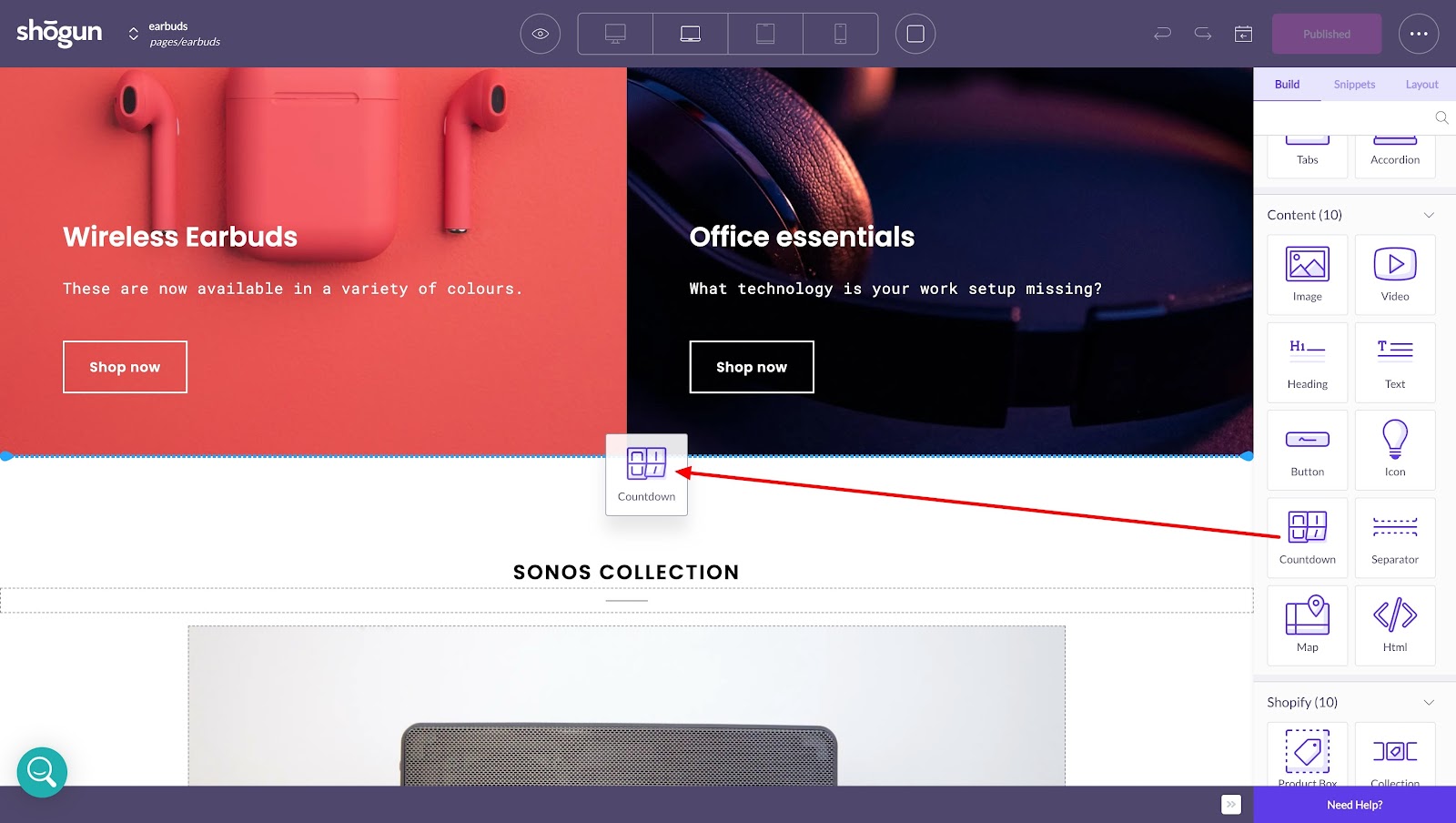
With a landing page designer like Shogun Page Builder, you can put together top-notch landing pages that match the intent of your ads.
Pro tip: Make your landing page headline closely mirror the headline you use in your ad. After all, they clicked for a reason—give them what they want.
Following it up with powerful product photos, a compelling product description, and a clear call to action will just drive visitors deeper into your sales funnel and closer to the sale.
#cta-visual-pb#<cta-title>Create an amazing landing page today<cta-title>Ensure they convert by sending paid traffic to landing pages that match their intent, nurturing them toward the sale.Start designing now
Types of ecommerce advertising
Ads come in all shapes and sizes, on all manner of sites and services. For online retailers, it’s important to know their various options for advertising.
Here, we’ll cover some of the biggest players in online ecommerce advertising:
Google is a search engine behemoth, with over 85% of the search market in 2022. All others languish in the single digits.
Their dominance means huge amounts of ad revenue from advertisements on search, YouTube, and partnered sites.
The following are the types of Google ads that online retailers can use to drive traffic to their stores.
Google display ads
These are visual ads that come in a variety of sizes—from 200×200 for mobile to as large as 300×600 for desktop. You can use still images or animate your ads for attracting more eyes.
They are displayed across the Google Display Network (GDN), which encompasses more than 200 million websites (plus apps and videos).
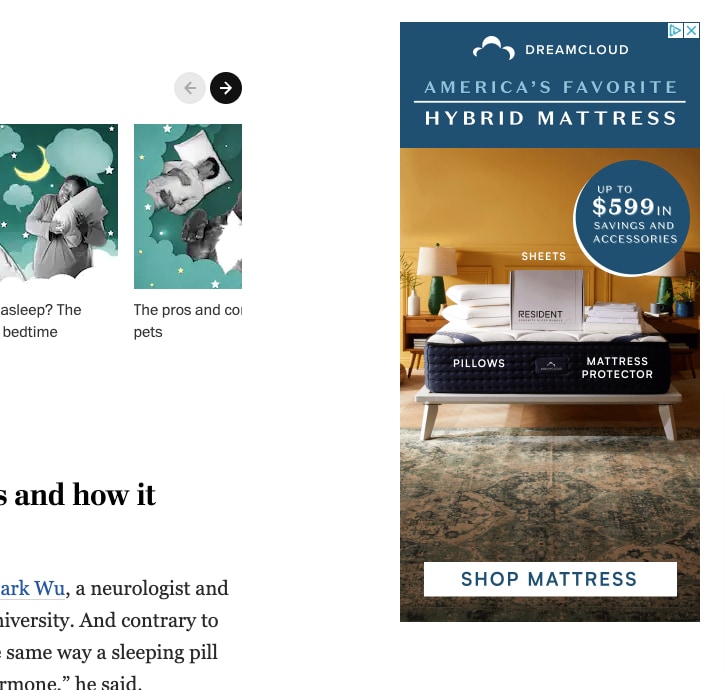
Ads are shown to visitors based on audience targeting.
This may be audiences that have just started searching for a certain topic (in-market), those who already have interest in the topic (affinity), and audiences defined by the business (custom).
Google search ads
Google Search funnels much of the world’s traffic to the various sites and stores of the internet. There are two ways to get pages in the first page of results—via SEO and via search ads.
These ads are text-based, built to look like organic search results, with a headline, a short description, and a URL (plus the small indication that it is an ad).
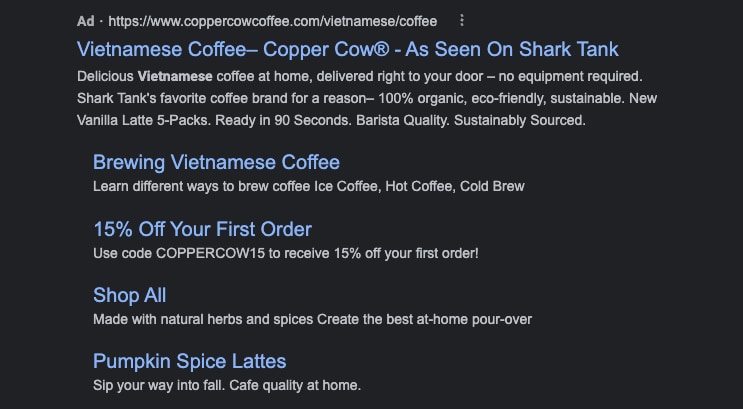
The strategy for search ads to to bid on target keywords, paying the bidded cost per ad click. Depending on the popularity of the keyword, your cost per click will vary.
Another option is dynamic search ads, which use the content on your website to dynamically generate search ads that fit searcher intent. These can use your entire site or specific pages you want to send traffic to.
Text ads can also show up across the Google Display Network, using your headline and description in an imageless banner.
Google Shopping ads
There are plenty of situations where shoppers want to get straight to a product, knowing just what type of thing they want.
Google Shopping ads show up for certain searches, serving up specific products complete with images and pricing.
When these high-intent shoppers click through from the ad to your product page, they are very likely to purchase.
Google Shopping ads appear at the top of or to the right of your search results page, at the top of the Google Shopping tab (in Google Search), and on Google Search Partner sites.
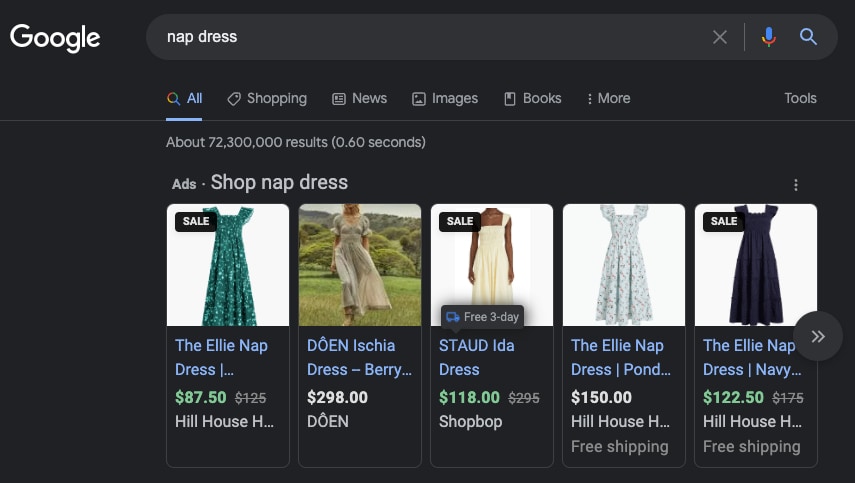
You add your product info to the Merchant Center feed and then start building ad campaigns. Google uses product data instead of keywords to serve up these ads, matching user intent.
For these ads, you only pay per click to your landing page. The cost is governed via ad auction, like with search ads, up to your maximum bid amount.
You can also list your products for free on Google Shopping (and you should), in which case the listings will show up beneath the ads on the Google Shopping tab.
Integrate Google Shopping with your ecommerce platform of choice (like Shopify, BigCommerce, Adobe Commerce, etc).
Google retargeting ads (AKA remarketing)
Using a Google tag on your store pages, you can show display ads to people who have already visited your store, encouraging them to return and purchase.
This is a particularly affordable way to advertise online. The audience already has interest and intent built in and the cost per click is relatively low.
As shoppers visit sites throughout the Google Display Network, you brand will show up and remind them of what they were shopping for.
#cta-visual-pb#<cta-title>Send that hard-won traffic to the right page<cta-title>Don’t leave it up to fate—take control of your sales funnel by building dedicated landing pages for your incredible ads.Start designing now
In the world of social media, there is none bigger than Facebook. Singularly, the platform now commands nearly 72% of social media market share.
After having acquired other platforms like Instagram and WhatsApp, the company rebranded as Meta. With so many users interacting on its platforms, they have audience targeting like no other.
In this guide, we’ll discuss Facebook and Instagram separately despite the two using the same advertising backend.
For both platforms, you choose the objective you want to achieve from the campaign—for ecommerce stores, that’ll likely be traffic, brand awareness, or engagement.
Facebook ads are powerful for ecommerce brands, with audience targeting that can get your product in front of exactly the right eyes.
Facebook image ads
Just as they are called, these ads include one image plus a headline, description copy, and primary text.
The aspect ratio for these ads depends on the placement but will be 1.91:1 to 1:1 or 9:16.
There are different placement types for image ads:
- In the main feed
- In the right column (above contacts)
- Within Facebook Marketplace
- In Facebook Stories
- In search results
- In Messenger
- Facebook in-stream video
Below you can see the main feed ad and the right column ads. Depending on the format, the amount of copy you can include will change.
There are multiple options for CTA text that depend on your ad objective—from brand awareness and reach to traffic and engagement.
For ecommerce, you’ll likely end up using CTAs like ‘Shop now’, ‘Learn more’, or ‘Get offer’ to drive traffic to your store.
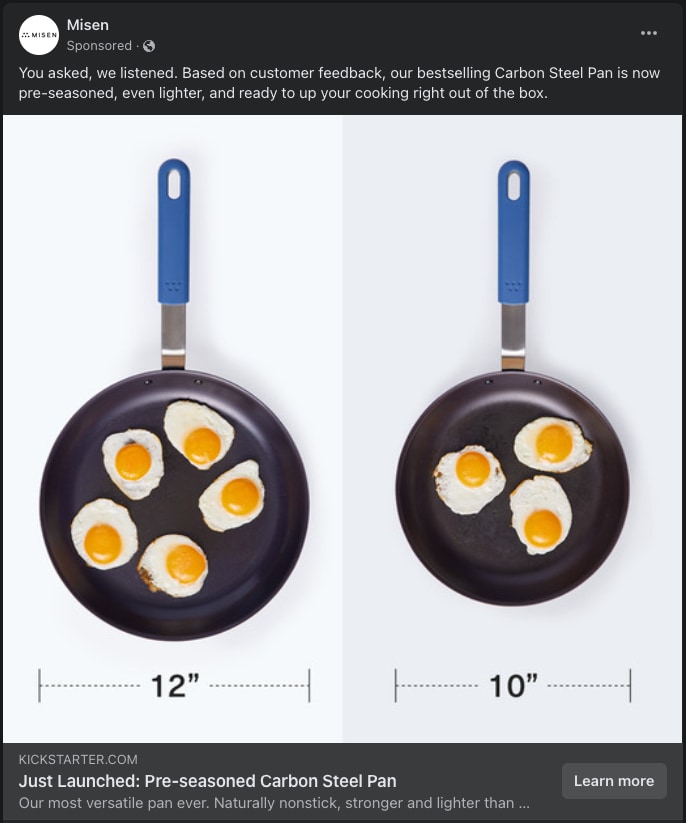

While image ads are the most basic option for Facebook ads, they can be quite effective.
It could very well hinge on how creative your product photography is, which will entice people to click through and buy.
Facebook video ads
Similar in many respects to the image ad, video ads draw the visitors’ attention with motion. Depending on the placement, the copy options and character limits will vary.
Video ad placements include:
- The main feed
- Facebook Marketplace
- Facebook Stories
- Search results
- Reels
- Facebook in-stream video
The video aspect ratios are different depending on the placement.
For some, like the main feed, search results, and Marketplace, you’ll aim for a 1:1 (or 4:5) ratio. For others, like Reels and Stories, you’ll need a 9:16 ratio.
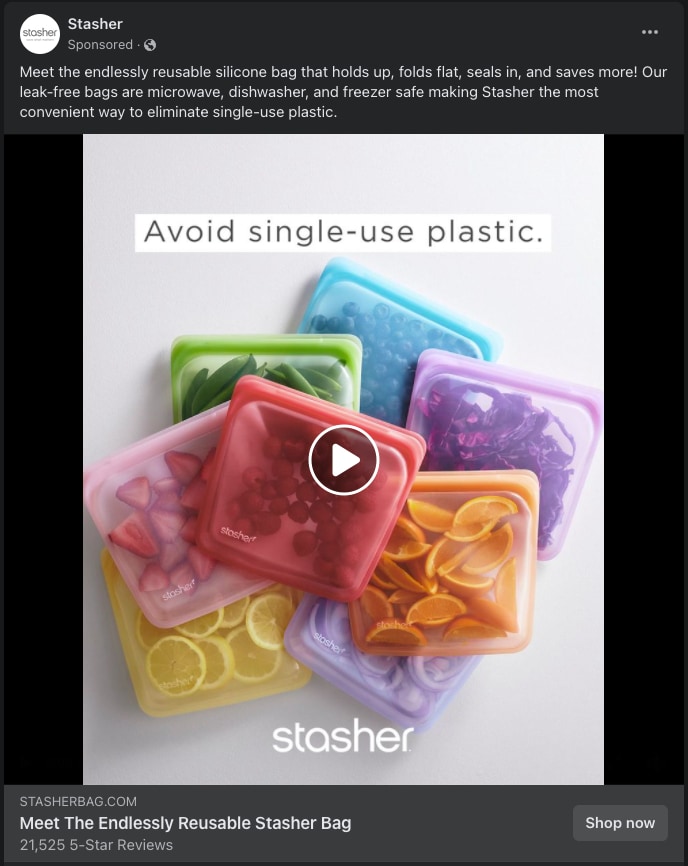
Video can help tell your product story quickly, catching the attention of your audience and helping to drive them toward a sale faster.
We’ve talked about how important it is to add video to your store, and it’s just as important to create videos for ads to pull more shoppers to your store. This format works great for video testimonial UGC, which is always a winner with new shoppers.
Facebook carousel ads
Where image and video ads succeed, carousel ads can compound that success.
For these ads, you can include up to 10 images or videos that users can swipe through, each with their own link.
Placements for carousels include:
- The main feed
- The right column (only the first image will show)
- Facebook Marketplace
- Search results
- Facebook Stories
- Facebook in-stream video
So, you could include several products with an image of each and a link to the individual product landing pages or product detail pages.
Or, you could use the strategy seen below by Cometeer where the images show step-by-step how to brew their innovative coffee, with all links going to the same dedicated landing page.

When you have multiple related products or a product that would benefit from showing its many sides, the carousel ad is a power player.
Facebook collection ads
This ad type allows mobile users to browse a few of your products and upon clicking sends them to an Instant Experience (explained below) to dive deeper into your offering.
You must create an Instant Experience ad to be able to use collection ads.
Placements for collections include:
- The main feed
- Facebook in-stream video
Each ad consists of one cover image or video and three or four product images. Products can be manually selected or chosen dynamically by Facebook from your catalog.
For copy, they include a headline and some primary text.
You will include a landing page for the resulting traffic to end up, so make sure to build an excellent on-message landing page for this purpose.
Instant Experience ads
These mobile-only ads allow for a more interactive experience for shoppers, opening in full-screen mode once the ad is tapped.
This is available for ads in both Facebook and Instagram.
In Facebook, it works with all the above ad formats—image, video, carousel, and collection—and adds additional functionality like scrolling, swiping, and clicking through to individual product pages.
You can choose from existing templates or build your Instant Experience ads totally custom in the Ads Manager.
Templates include:
- Lookbook. Lifestyle product photos with tags that link to products.
- Storefront. A mobile mockup of a store with products from your catalog.
- Customer Acquisition. A simple action-oriented experience that drives users to purchase.
- Storytelling. Tell a story with images and videos.
- Sell Products (Without Catalog). Like the Storefront template but products need to be uploaded.
- AR Experience. Create an augmented reality effect from your images or videos.
Facebook slideshow ads
These ads give you the motion aspect of video ads while loading more quickly for users. They are also simpler to make than videos which means production is much more affordable.
You can use between three and 10 images (with aspect ratios of 16:9, 1:1, or 2:3) for a slideshow ad that can total up to 15 seconds in length. The ad will continue looping as users view it.
You can even add audio to enhance the experience.
Using five times less data than video ads, slideshow ads work great in markets with slower internet connections.
Facebook retargeting ads
Just as with Google, Facebook has its own tracking snippet—called a pixel—that you can add to your store to track user behavior and serve up relevant ads.
So, for instance, if a visitor to your store was looking at a particular pair of pants, you could later show them ads for those pants on Facebook.
If all goes well, the shopper will say, “Ah yes, of course, those pants I intended to buy!” and you’ve converted yet another shopper. They get new pants and you get a new customer.
Another of Meta’s social media platforms, Instagram’s visual format is a perfect fit for ecommerce brands.
Ads come in the same forms as do the post types that users enjoy—main feed image and video posts, Stories, and Reels.
Being under Meta’s umbrella, both Facebook and Instagram ads are managed in the same places, the Creative Hub and the Ads Manager.
#cta-paragraph-pb#Are you posting when your audience is online? Learn the best times to post on Instagram for better engagement.
Instagram image ads
Much like Facebook’s image ads, Instagram’s image ads use one image plus copy. Copy will at least include primary text, but may also involve a headline and up to 30 hashtags.
Image ads on Instagram are a simple yet effective way to get your brand in front of an audience that is heavily influenced by ads.
Aspect ratios vary based on placement but will need to be 9:16 or 1:1.
Placements for Instagram image ads include:
- The main feed
- Instagram Explore
- Instagram Stories
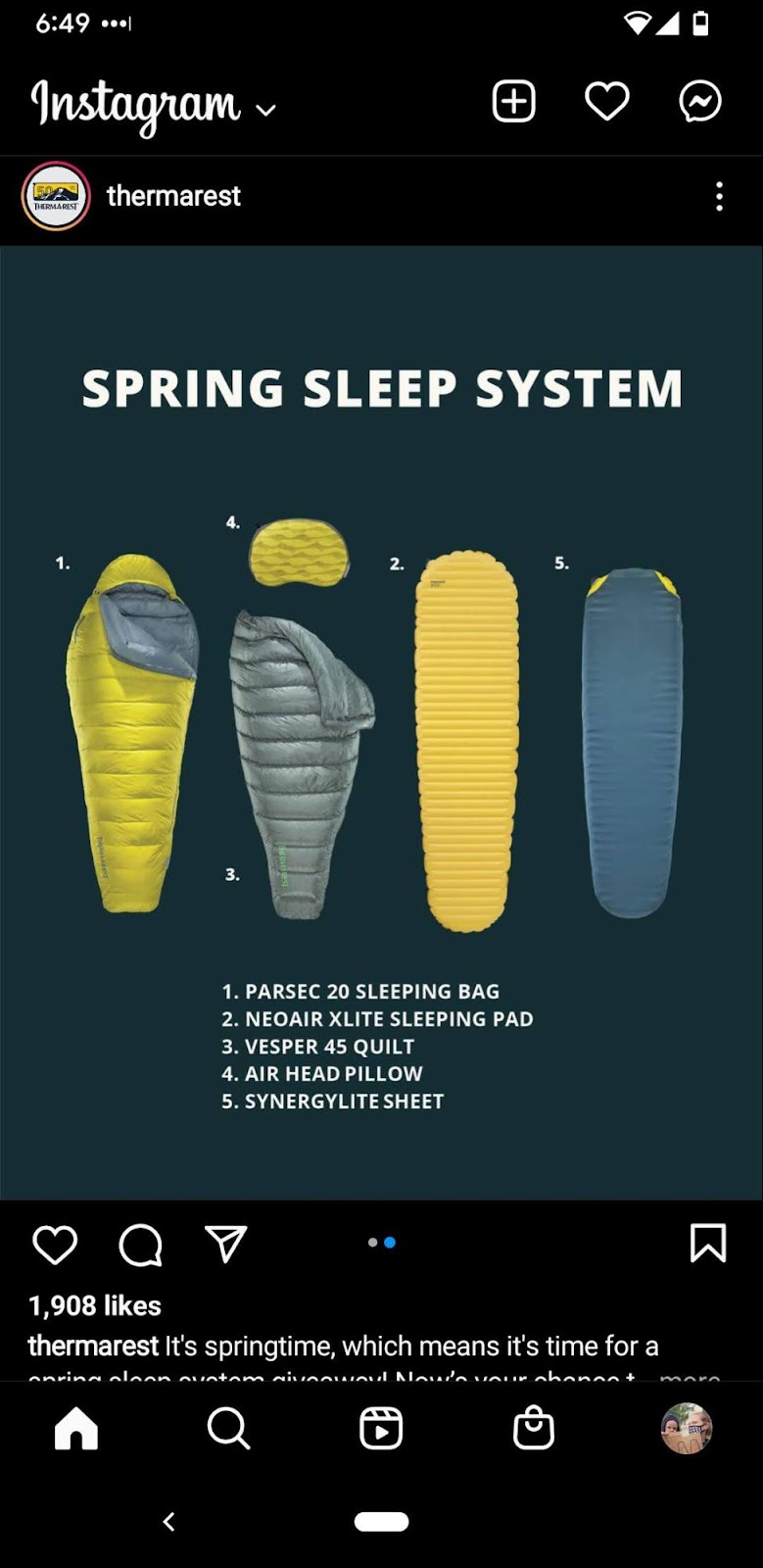
Image ads work really well for brands with products that can be easily understood from one image. Great photography can help make that one photo tell a powerful story.
Instagram video ads
For products that require a bit more explanation, video ads fit the bill nicely.
Not only do videos condense a lot of information into one asset, but visitors are drawn to the movement.
The aspect ratio for video ads on Instagram is either 4:5 or 9:16, depending on the placement format.
Videos can be as long as 60 minutes, but nobody is asking for a movie in their feed.
Keep your videos short and to the point to keep viewers interested—somewhere between 5-15 seconds should be perfect.
Placements for Instagram video ads include:
- The main feed
- Instagram Explore
- Instagram Stories
- Instagram Reels

As with the example above, some products reveal themselves more fully in a video—the visual of coffee being poured and steam rising evokes desire in the viewer (or at least in me).
Make sure you spend time getting the product video right, since every second counts. Your first few seconds will decide whether or not they keep watching, let alone click through.
Instagram carousel ads
This ad format allows you to use multiple images and videos to fully explore one or more products in one ad.
It can feature several different products, tell your brand story, or demonstrate how your product works.
Working exactly like a multi-image organic post on Instagram, carousel posts allow users to swipe through up to 10 images or videos, with each slide able to link to a different landing page.
The aspect ratio for carousel ads is 1:1, just as with normal Instagram posts.
Placement for carousel ads includes:
- Instagram Stories
- The main feed
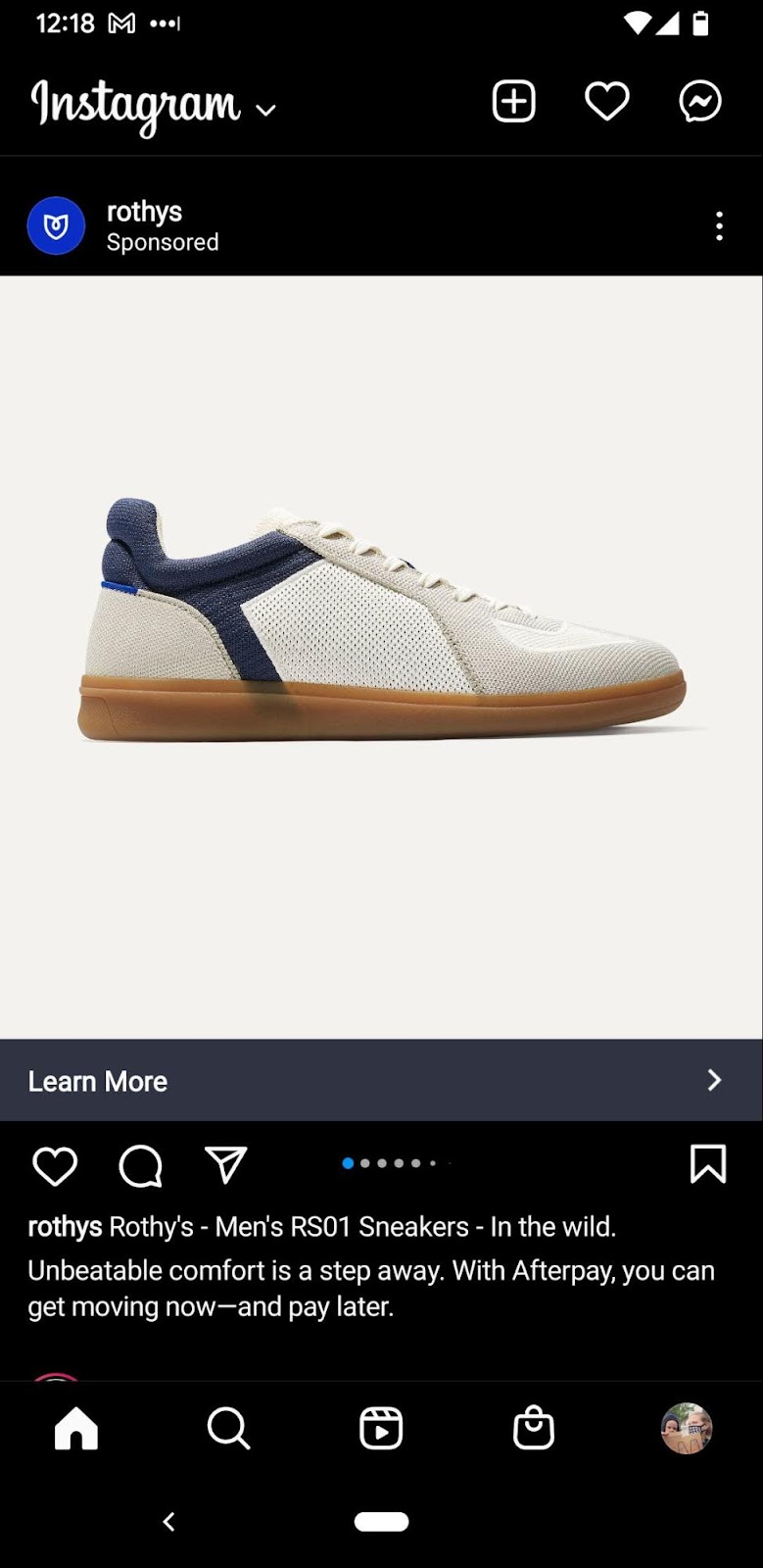
In your feed, carousel posts will show up like the above from Rothy’s. In Stories, you’ll see up to 10 image or video stories in a row.
This is as close as you can get in an ad to your product page’s image gallery, which you spent so much time perfecting.
You could even just pull your gallery into a carousel ad and drive the traffic back to your matching product page.
Instagram collection ads
As with Facebook, collection ads in Instagram are directly tied to an Instant Experience ad (explained earlier), which opens upon tapping.
With one cover image or video and two or three product images, collection ads entice users to click through to see more of your product line in the Instant Experience ad.
The first asset used in your Instant Experience ad will be your cover image or video. The aspect ratio for that is 1.91:1 to 1:1.
You can either create a custom Instant Experience ad or choose between the Storefront or Customer Acquisition templates.
Placements for collection ads include:
- Instagram Stories
- The main feed
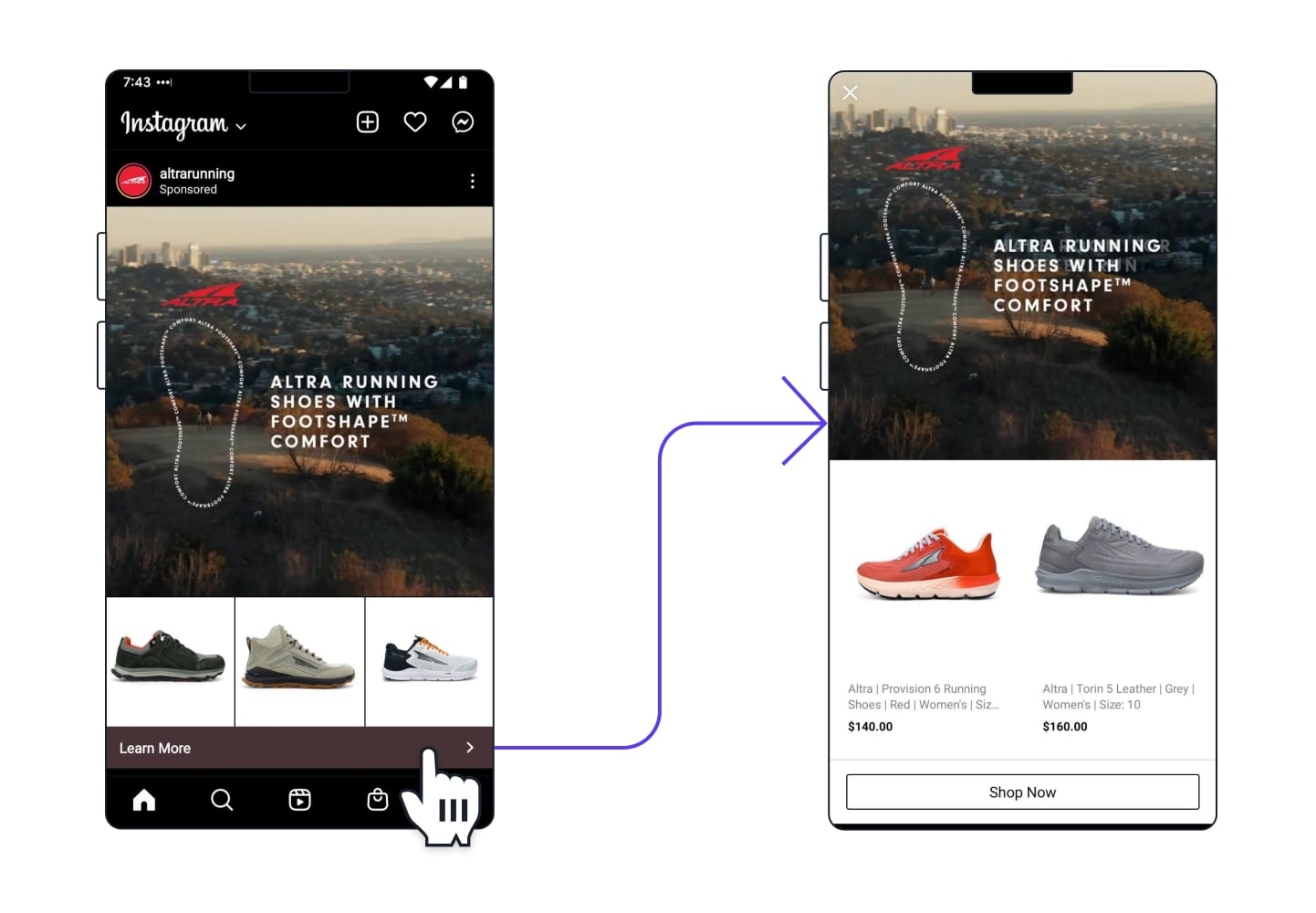
In the above example from Altra, after tapping on the ad I was served the Instant Experience ad that allowed me to scroll through more products and click through to a main landing page or individual product pages.
Instagram Stories ads
In between Stories from your friends, family, and celebrities, you’ll see vibrant visual ads.
Stories ads are powerful, encompassing the user’s full phone screen and encouraging them to find out more about the product or service.
And they work. 58% of Instagram users say they are more interested in a brand or product after seeing it in Stories. Author note:I’m currently wearing pants I first saw on an Instagram Story.
Stories ads aren’t their own format, but one placement option for any of the above discussed ad formats. So, you can use images, videos, carousels, and collections to build out your Stories ads.

As you can see from the above examples from Cowboy Bikes and East Fork Pottery, you can use multiple formats and assets to build out your Stories ads, making for a rich and somewhat interactive ad experience (even moreso if using Instant Experience).
Instagram Shopping ads
For stores that take advantage of Instagram Shopping, there is another dimension to running ads on the platform.
By adding product tags to your ads, you can drive users straight to your in-app shop, where they can buy your stuff without even leaving Instagram.
#cta-paragraph-pb#Learn more about Instagram Shopping from our guide to selling on Instagram with your Shopify store.
Find the right ads to get in front of the right audience
As you can see, there are tons of ways for ecommerce brands to advertise their amazing products online.
Figure out where your audience likes to hang out, build out your perfect target audiences and keywords, then push the gas until your ROI gives out.
The fact is that you can make more money than you spend if you do paid advertising right. As always, you need to test and measure and iterate to increase your ROI.
Eventually, you’ll have it down to a science and you’ll have a ton of new customers to show for it.
#cta-visual-pb#<cta-title>Create the perfect landing pages for your paid traffic<cta-title>Take control of your sales funnel by building dedicated landing pages for your incredible ads.Start designing now

Sean Flannigan
Sean is one of Shogun's tireless content marketers. When he isn't creating exciting ecommerce content, he's probably biking or at the park.



